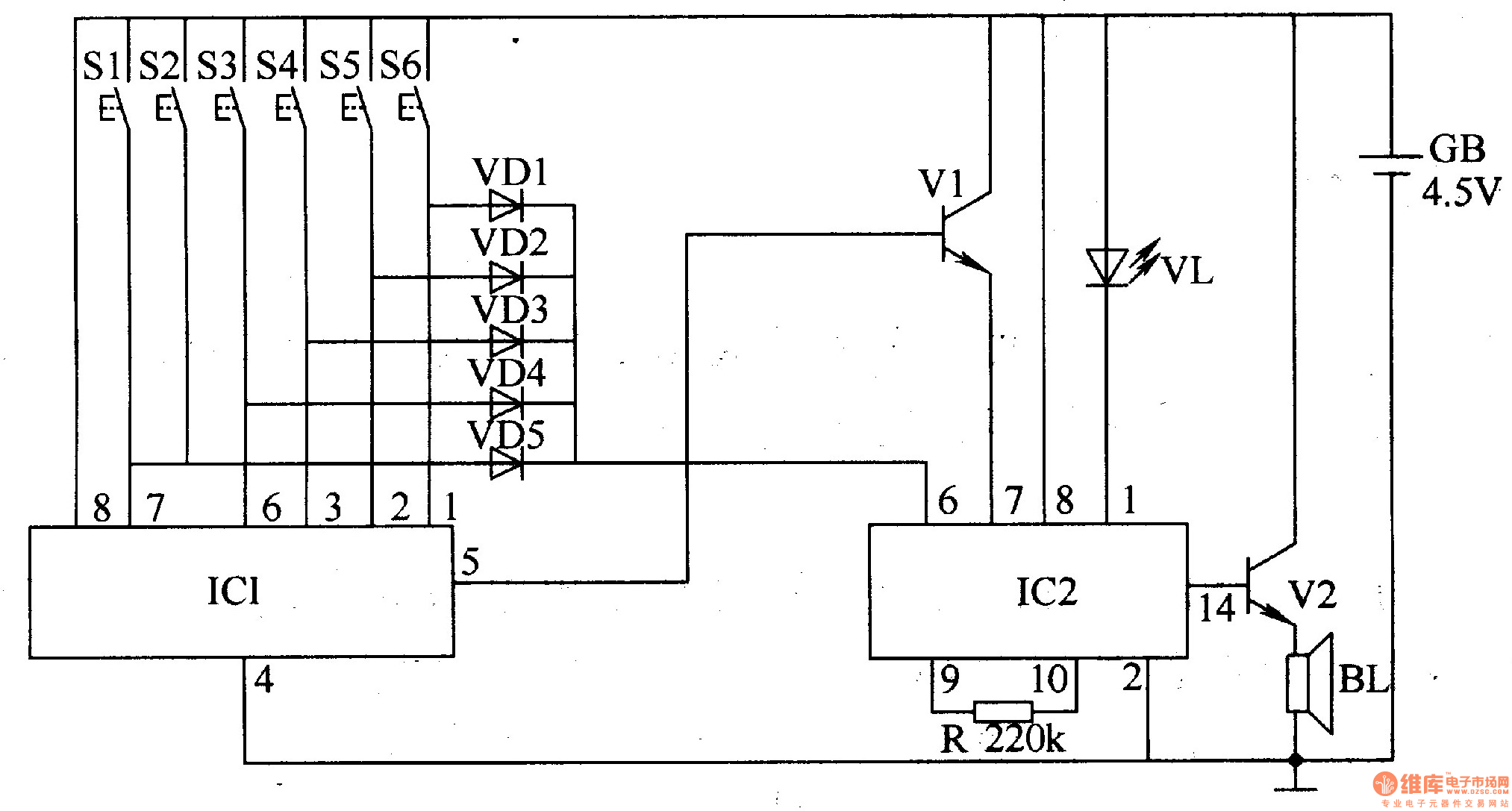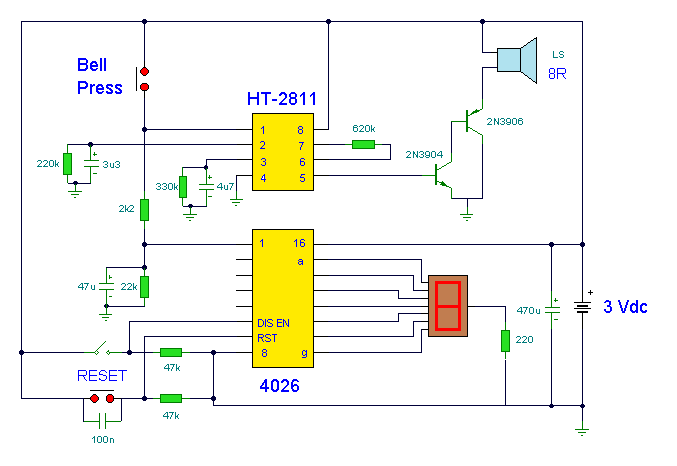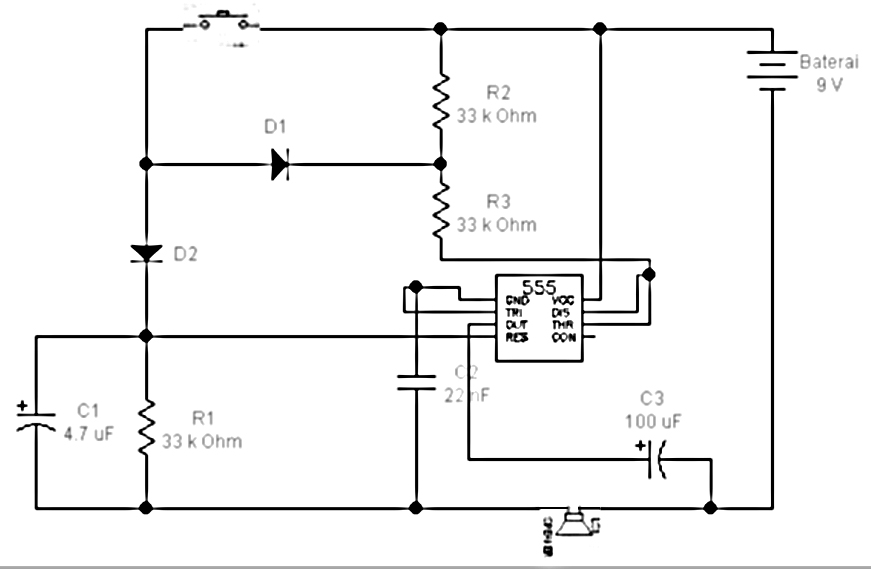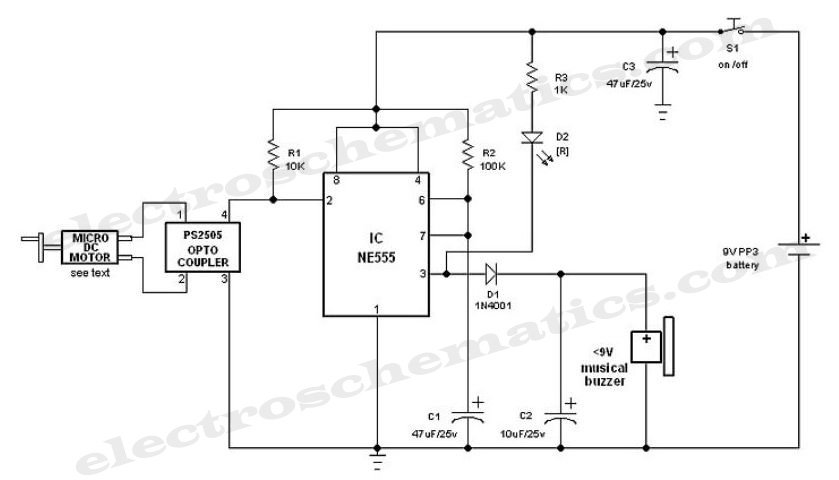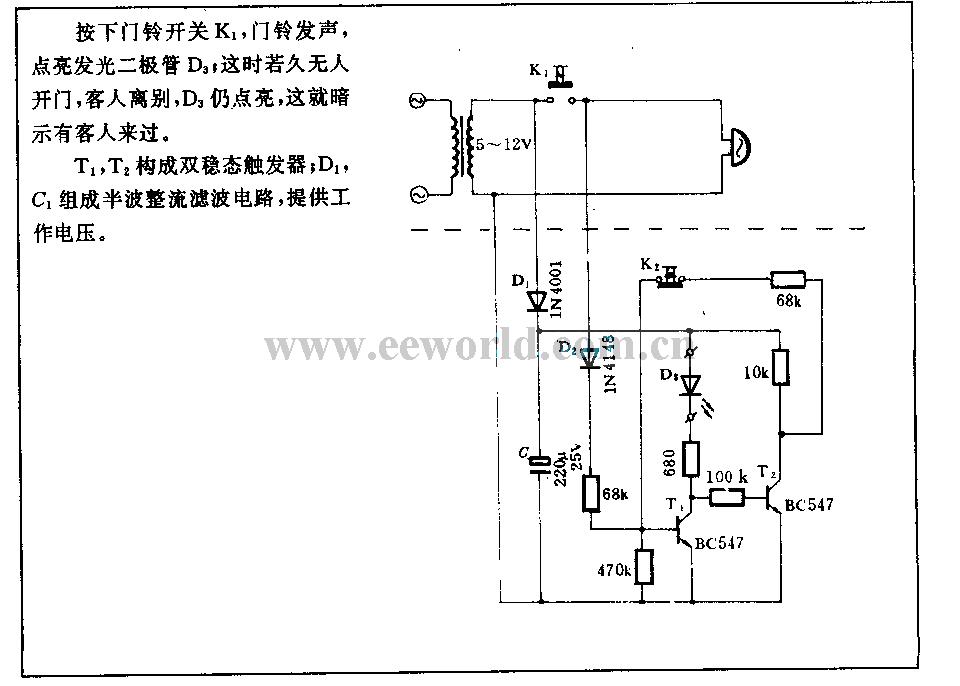
Doorbell MemoryCircuit
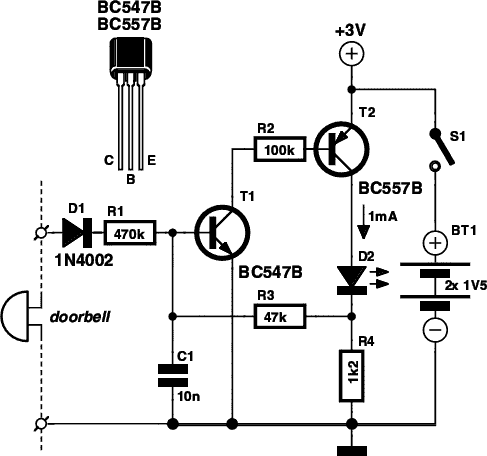
If expecting an important visitor but needing to step out for a moment, an electronic doorbell memory can be useful to check if someone rang while away. Although it may not indicate whether the expected visitor arrived, a quick call to their mobile phone can clarify the situation. A doorbell memory also eliminates the need to check the front door when unsure if the bell was heard, especially for those living upstairs. If purchasing one is not an option, it can be built with a few electronic components to create a simple device with an LED that signals when the doorbell button is pressed. Many people have experienced the uncertainty of whether they heard the doorbell while watching television, as the familiar "ding dong" chime often occurs during inconvenient commercial breaks. A glance at the LED of the doorbell memory will reveal if it is necessary to answer the door or if it is safe to change channels. Additionally, if one is expecting a visitor but needs to quickly step out, the device allows for confirmation of their arrival. The circuit is straightforward and connects in parallel with the bell, powered by a 3-V supply created by two 1.5-V penlight batteries in series. The low current draw ensures that the batteries will last for years under normal use. The operation is as follows: when the supply voltage is activated with switch S1, capacitor C1 (initially uncharged) prevents transistors T1 and T2 from conducting, keeping LED D2 off and the memory armed. When the doorbell button is pressed, the memory circuit receives an AC or DC voltage through diode D1, accommodating both types. This provides base current to transistor T1, initiating conduction and subsequently driving T2 into conduction. The LED illuminates to indicate that the doorbell has rung. The combination of transistor T2 and resistor R3 maintains T1's conduction after the bell voltage ceases when the button is released. The memory remains active until switch S1 is opened, which serves as both a reset and power switch. The circuit can be compactly assembled on a small piece of perforated prototyping board, allowing it to fit into nearly any doorbell model. Transistors can be substituted with other equivalent types, provided a combination of NPN and PNP types is used.
The electronic doorbell memory circuit is designed for simplicity and efficiency, making it an accessible project for hobbyists and electronics enthusiasts. The core components include two transistors (one NPN and one PNP), a diode, a capacitor, an LED, a switch, and a resistor. The transistors function as switches that control the flow of current based on the doorbell's activation. The diode ensures that the circuit can handle either AC or DC input, making it versatile for various doorbell types.
The power supply, consisting of two 1.5-V batteries, is chosen for its compact size and longevity. The low current consumption of the circuit means that the batteries can last several years, making it practical for everyday use. The use of a capacitor to initially block current flow until the system is armed adds a layer of reliability, ensuring that the LED only lights up when the doorbell is pressed.
The design allows for easy assembly on a perforated prototyping board, which can be cut to fit within the casing of an existing doorbell. This makes it an ideal project for those looking to enhance their doorbell system without needing specialized equipment or extensive knowledge of electronics. Overall, this electronic doorbell memory circuit is a valuable addition to any home, providing peace of mind and convenience for users.If you`re expecting an important visitor but you just have to step out for a moment, an electronic doorbell memory can come in handy so you can see whether someone rang while you were out. Of course, you can`t tell whether it was the visitor you were expecting who dropped by then, but a call to the mobile phone of the person concerned can quickly
answer that question. A doorbell memory can also save you the trouble of going to the front door (if you live upstairs) when you think you heard the bell but aren`t sure. And if you can`t buy one, then of course you can build one yourself! Read on to find out how. It takes only a handful of electronic components to build a handy tale-tale with an LED that indicates whether someone pressed the button of your doorbell.
How many times have you thought you heard your doorbell while watching television in the evening The sound of the well-known ding dong` chimes occurs all too often, especially during the many commercials that nowadays remind us at the most inconvenient times that the gripping film we`re watching is only a fantasy. A glance at the LED of the doorbell memory will tell you whether you have to go to the door or can try to escape the ads by zapping to a different channel.
Or if you`re expecting someone but have to make a quick trip to the neighbors to borrow a few beers for the occasion, it can be handy to be able to see whether your visitor already arrived while you were out. If so, you can always call him or her on the mobile to confess that you hadn`t properly prepared for the expected visit.
The circuit is as simple as it is effective. It is connected in parallel with the bell and powered by a 3-V supply formed by two 1. 5-V penlight batteries connected in series. The doorbell memory draws so little current that a set of batteries will last several years in normal use. The circuit works as follows. When the supply voltage is switched on with switch S1, capacitor C1 (initially uncharged) prevents transistors T1 and T2 from conducting.
LED D2 is off, and the memory is armed. When the doorbell button is pressed, the memory circuit receives an AC or DC voltage via diode D1, depending on the type of doorbell. It can handle either type. Transistor T1 thus receives a base current, so it starts conducting and drives T2 into conduction. The LED lights up as an indication that the doorbell has rung (i. e. was energized). The combination of transistor T2 and resistor R3 keeps T1 conducting after the bell voltage goes away (when the button is no longer pressed).
The memory remains in this state until switch S1 is opened. This switch thus acts as a reset switch as well as a power switch. The circuit can be assembled compactly on a small piece of perforated prototyping board, so it can be fitted into just about any model of doorbell. The transistors can be replaced by other, equivalent types as long as you use a combination of NPN and PNP types.
🔗 External reference
The electronic doorbell memory circuit is designed for simplicity and efficiency, making it an accessible project for hobbyists and electronics enthusiasts. The core components include two transistors (one NPN and one PNP), a diode, a capacitor, an LED, a switch, and a resistor. The transistors function as switches that control the flow of current based on the doorbell's activation. The diode ensures that the circuit can handle either AC or DC input, making it versatile for various doorbell types.
The power supply, consisting of two 1.5-V batteries, is chosen for its compact size and longevity. The low current consumption of the circuit means that the batteries can last several years, making it practical for everyday use. The use of a capacitor to initially block current flow until the system is armed adds a layer of reliability, ensuring that the LED only lights up when the doorbell is pressed.
The design allows for easy assembly on a perforated prototyping board, which can be cut to fit within the casing of an existing doorbell. This makes it an ideal project for those looking to enhance their doorbell system without needing specialized equipment or extensive knowledge of electronics. Overall, this electronic doorbell memory circuit is a valuable addition to any home, providing peace of mind and convenience for users.If you`re expecting an important visitor but you just have to step out for a moment, an electronic doorbell memory can come in handy so you can see whether someone rang while you were out. Of course, you can`t tell whether it was the visitor you were expecting who dropped by then, but a call to the mobile phone of the person concerned can quickly
answer that question. A doorbell memory can also save you the trouble of going to the front door (if you live upstairs) when you think you heard the bell but aren`t sure. And if you can`t buy one, then of course you can build one yourself! Read on to find out how. It takes only a handful of electronic components to build a handy tale-tale with an LED that indicates whether someone pressed the button of your doorbell.
How many times have you thought you heard your doorbell while watching television in the evening The sound of the well-known ding dong` chimes occurs all too often, especially during the many commercials that nowadays remind us at the most inconvenient times that the gripping film we`re watching is only a fantasy. A glance at the LED of the doorbell memory will tell you whether you have to go to the door or can try to escape the ads by zapping to a different channel.
Or if you`re expecting someone but have to make a quick trip to the neighbors to borrow a few beers for the occasion, it can be handy to be able to see whether your visitor already arrived while you were out. If so, you can always call him or her on the mobile to confess that you hadn`t properly prepared for the expected visit.
The circuit is as simple as it is effective. It is connected in parallel with the bell and powered by a 3-V supply formed by two 1. 5-V penlight batteries connected in series. The doorbell memory draws so little current that a set of batteries will last several years in normal use. The circuit works as follows. When the supply voltage is switched on with switch S1, capacitor C1 (initially uncharged) prevents transistors T1 and T2 from conducting.
LED D2 is off, and the memory is armed. When the doorbell button is pressed, the memory circuit receives an AC or DC voltage via diode D1, depending on the type of doorbell. It can handle either type. Transistor T1 thus receives a base current, so it starts conducting and drives T2 into conduction. The LED lights up as an indication that the doorbell has rung (i. e. was energized). The combination of transistor T2 and resistor R3 keeps T1 conducting after the bell voltage goes away (when the button is no longer pressed).
The memory remains in this state until switch S1 is opened. This switch thus acts as a reset switch as well as a power switch. The circuit can be assembled compactly on a small piece of perforated prototyping board, so it can be fitted into just about any model of doorbell. The transistors can be replaced by other, equivalent types as long as you use a combination of NPN and PNP types.
🔗 External reference
Warning: include(partials/cookie-banner.php): Failed to open stream: Permission denied in /var/www/html/nextgr/view-circuit.php on line 713
Warning: include(): Failed opening 'partials/cookie-banner.php' for inclusion (include_path='.:/usr/share/php') in /var/www/html/nextgr/view-circuit.php on line 713

